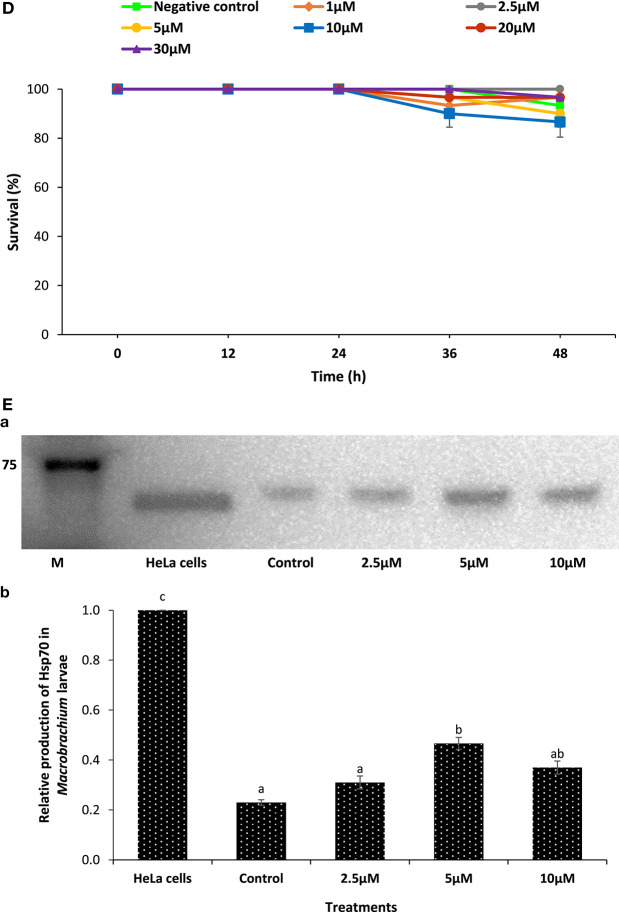Figure 4.
Pretreatment of xenic brine shrimp larvae and Macrobrachium larvae with phloroglucinol protects them against subsequent Vibrio parahaemolyticus challenge. (A) Survival (%) of phloroglucinol-pretreated xenic brine shrimp larvae after 48 h of challenge with V. parahaemolyticus MO904. The larvae were pretreated with phloroglucinol at the indicated doses for 2 h, rinsed to wash away the compound, and then allowed to recover for 2 h. The larvae were subsequently challenged with V. parahaemolyticus at 107 cells/ml of rearing water. Non-pretreated larvae that were either challenged with V. parahaemolyticus (positive control) or unchallenged (negative control) served as controls. Error bars represent the standard error of five replicates; different letters indicate significant differences (P < 0.001). (B) Proportion of survived of Macrobrachium larvae (8 days old) after 12, 24, 36, and 48 h post challenge with V. parahaemolyticus MO904 strain. Four infectious doses (104, 105, 106, and 107 cells/ml) were tested in the Macrobrachium larvae. The V. parahaemolyticus dose provoking significant mortality near to 80% at 24 h in Macrobrachium larvae was considered an optimum dose and selected for the experimental challenge. The unchallenged was served as negative controls. Values are presented as mean ± SE (n = 3). (C) The effect of phloroglucinol pretreatment on the survival of Macrobrachium larvae (8 days old) after 12, 24, 36, and 48 h post challenge with V. parahaemolyticus. The larvae were pretreated with phloroglucinol at the indicated doses for 2 h, rinsed to wash away the compound, and then allowed to recover for 2 h. The Macrobrachium larvae were subsequently challenged with V. parahaemolyticus at 106 cells/ml of rearing water. Non-pretreated larvae that were either challenged with V. parahaemolyticus (positive control) and those not challenged with V. parahaemolyticus (negative control) served as controls. Values are presented as mean ± SE (n = 3). Asterisks represent significant difference between the control and the treatment. *P < 0.05, **P < 0.01, ***P < 0.001, ****P < 0.0001, *****P < 0.00001, ******P < 0.000001, *******P < 0.0000001. (D) Toxicity of phloroglucinol to Macrobrachium larvae (8 days old). The larvae were pretreated with phloroglucinol at the indicated doses for 2 h, rinsed to wash away the compound, and then allowed to recover for 2 h. Non-pretreated larvae served as controls. Survival was recorded 48 h after the recovery period. Values are presented as mean ± SE (n = 3). (E) Induction of Hsp70 protein in Macrobrachium larvae (8 days old) pretreated with phloroglucinol at indicated doses. Non-pretreated larvae were maintained as control. (a) Protein extracted from different treatment groups was resolved on an SDS-PAGE gel and then transferred to a polyvinylidene fluoride membrane and probed with an antibody to brine shrimp Hsp70. Molecular mass standards (M) in kilodaltons are shown on the left. The induction of Hsp70 in HeLa cells was regarded as 1. (b) Quantitative analysis of Hsp70 levels in the brine shrimp larvae is presented relative to Hsp70 production in HeLa cells. Error bars represent the standard error of three replicates; different letters indicate significant differences (P < 0.001).


